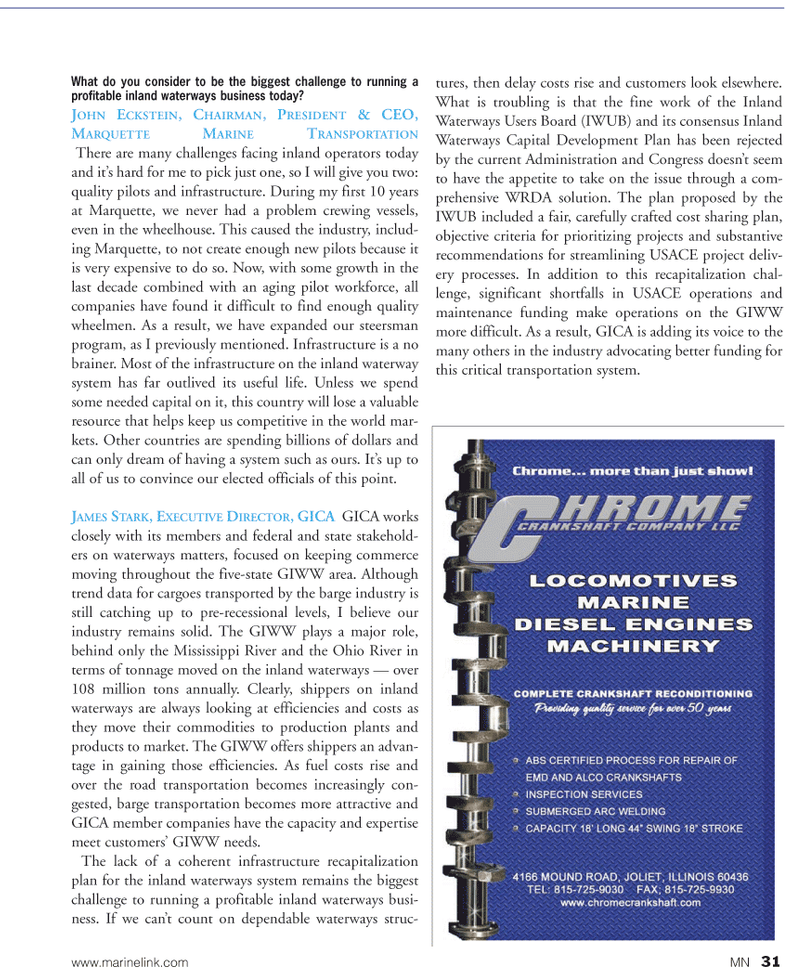
Page 31: of Marine News Magazine (June 2011)
CEO Six-Pack: The Leadership Edition
Read this page in Pdf, Flash or Html5 edition of June 2011 Marine News Magazine
www.marinelink.com MN 31
What do you consider to be the biggest challenge to running a profitable inland waterways business today?
JOHN ECKSTEIN, CHAIRMAN, PRESIDENT & CEO,
MARQUETTE MARINE TRANSPORTATION
There are many challenges facing inland operators today and it’s hard for me to pick just one, so I will give you two: quality pilots and infrastructure. During my first 10 years at Marquette, we never had a problem crewing vessels, even in the wheelhouse. This caused the industry, includ- ing Marquette, to not create enough new pilots because it is very expensive to do so. Now, with some growth in the last decade combined with an aging pilot workforce, all companies have found it difficult to find enough quality wheelmen. As a result, we have expanded our steersman program, as I previously mentioned. Infrastructure is a no brainer. Most of the infrastructure on the inland waterway system has far outlived its useful life. Unless we spend some needed capital on it, this country will lose a valuable resource that helps keep us competitive in the world mar- kets. Other countries are spending billions of dollars and can only dream of having a system such as ours. It’s up to all of us to convince our elected officials of this point.
JAMES STARK, EXECUTIVE DIRECTOR, GICA GICA works closely with its members and federal and state stakehold- ers on waterways matters, focused on keeping commerce moving throughout the five-state GIWW area. Although trend data for cargoes transported by the barge industry is still catching up to pre-recessional levels, I believe our industry remains solid. The GIWW plays a major role, behind only the Mississippi River and the Ohio River in terms of tonnage moved on the inland waterways — over 108 million tons annually. Clearly, shippers on inland waterways are always looking at efficiencies and costs as they move their commodities to production plants and products to market. The GIWW offers shippers an advan- tage in gaining those efficiencies. As fuel costs rise and over the road transportation becomes increasingly con- gested, barge transportation becomes more attractive and
GICA member companies have the capacity and expertise meet customers’ GIWW needs.
The lack of a coherent infrastructure recapitalization plan for the inland waterways system remains the biggest challenge to running a profitable inland waterways busi- ness. If we can’t count on dependable waterways struc- tures, then delay costs rise and customers look elsewhere.
What is troubling is that the fine work of the Inland
Waterways Users Board (IWUB) and its consensus Inland
Waterways Capital Development Plan has been rejected by the current Administration and Congress doesn’t seem to have the appetite to take on the issue through a com- prehensive WRDA solution. The plan proposed by the
IWUB included a fair, carefully crafted cost sharing plan, objective criteria for prioritizing projects and substantive recommendations for streamlining USACE project deliv- ery processes. In addition to this recapitalization chal- lenge, significant shortfalls in USACE operations and maintenance funding make operations on the GIWW more difficult. As a result, GICA is adding its voice to the many others in the industry advocating better funding for this critical transportation system.

 30
30

 32
32
